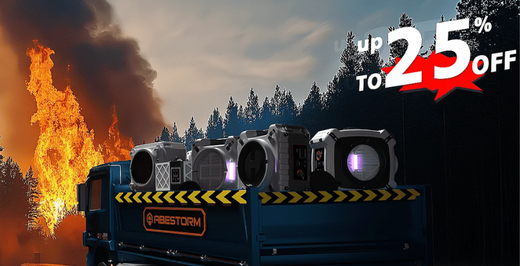Moisture is necessary for plants to be able to grow. They need plenty of water and sunshine to grow healthy and strong. However, too much of a good thing can be just as bad as not enough. Too much moisture at the wrong time can have an adverse effect on your most vulnerable plants and seedlings. In this article, you’ll learn about some simple things you can do to ensure your greenhouse environment is just right.
The Problem with Humidity
Humidity can pose a challenge for plants in greenhouses. Too much moisture and your plants might feel as though they are being pampered in a tropical spa, but they won't enjoy it. Excessive humidity can lead to mold, mildew, and problems with pests. On the flip side, too little humidity can stunt growth and result in dry, brown leaves and unhappy foliage. Striking just the right balance is key, and we're here to guide you through the process of balancing humidity control in your greenhouse oasis.
Identifying the Signs of High Humidity
Spotting the subtle indicators of high humidity in your greenhouse is crucial for proactive care. These telltale signs will alert you that help is needed to restore balance in the greenhouse ecosystem for your flourishing plants.
Condensation on Surfaces: Check for water droplets forming on the inner surfaces of greenhouse walls or on plants. It's like your greenhouse is sweating.
Foggy or Cloudy Appearance: If your greenhouse often looks like it's under a gentle mist, that could be a sign of excessive humidity.
Mold Growth: Keep an eye out for mold on soil surfaces, plant leaves, or greenhouse structures. It's a telltale sign that moisture levels are too high.
Drooping or Yellowing Leaves: Plants communicate through their leaves, and if they start looking sad – drooping or turning yellow – it might be due to too much moisture.
Waterlogged Soil: Stick your fingers into the soil. If it feels consistently wet or waterlogged, it could be a sign that the humidity is too high.
Insect Infestations: High humidity attracts pests like aphids and spider mites. Keep an eye out for increased insect activity.
Optimal Humidity Levels for Greenhouses

The ideal humidity level in a greenhouse is typically 80% during the day and 75% at night. Most plants benefit from temperatures between 64 and 75 degrees F. Striking this balance is crucial for plant health and growth. Too high, and it becomes a breeding ground for mold, diseases, and pests. Too low, and your plants may struggle to thrive. Monitoring and adjusting humidity levels is akin to providing your greenhouse with a personalized climate, ensuring optimal conditions for photosynthesis and overall plant well-being. Aim for that sweet spot – not too humid, not too dry – to create a harmonious environment where your plants can flourish.
Helpful Solutions To Reduce Humidity
What can you do to combat excess humidity? Here are a few suggestions for natural ways to reduce indoor humidity in greenhouses:
Proper Ventilation: Ensure good airflow by using exhaust fans, louvers, or ridge vents to allow humid air to escape.
Natural Ventilation: Take advantage of natural ventilation by opening windows and doors during dry and breezy conditions.
Strategic Fan Placement: Position fans strategically to promote air circulation, preventing pockets of stagnant, humid air.
Proper Watering Practices: Water plants early in the day to allow excess moisture to evaporate before evening.
Evaporation: Warmer temperatures can facilitate the evaporation of excess water from plant surfaces and soil, helping to maintain a more balanced humidity level.
Temperature Control: Maintain an optimal temperature, as warmer air can hold more moisture. Use shade cloth to regulate sunlight.
Check for Leaks: Regularly inspect the greenhouse for leaks or water accumulation that could contribute to humidity.
Add a dehumidifier: They are heavy-duty workhorses in the battle against humidity. Not only do they excel in reducing excess moisture, but these remarkable devices also play a crucial role in maintaining optimal humidity levels.
Dehumidifiers Are the Unsung Hero
Dehumidifiers regulate air moisture, achieving the perfect humidity balance for living spaces and greenhouses. This ensures a comfortable, healthier atmosphere, making them indispensable for ideal humidity conditions. Say goodbye to damp issues and welcome a controlled, harmonious environment.
Let's take a closer look at how dehumidifiers work. These ingenious devices operate on a simple yet effective principle. As moist air circulates through the dehumidifier, it encounters a set of coils that cool the air, causing the moisture to condense into water droplets. This condensed water is then collected in a reservoir or drained away, effectively reducing the humidity in the air.
Meanwhile, the now-drier air is reheated and released back into the greenhouse. This cyclical process ensures a continuous extraction of excess moisture, maintaining an optimal humidity level for your plants. Think of it as a diligent assistant, tirelessly creating a balanced and conducive atmosphere for your botanical companions to thrive.
Why Do You Need a Dehumidifier in the Greenhouse?
Your greenhouse is a lush haven for your beloved plants. But excessive humidity is lingering in the air, playing the villain in your botanical haven. This is where a dehumidifier can be most helpful.
In greenhouse gardening, moisture control is paramount. High humidity might seem innocuous, but it's the perfect breeding ground for pests and diseases, putting your plants at risk. More than that, it hampers their growth, stifling their potential.
Enter the dehumidifier, your ally in maintaining the perfect environment. By extracting excess moisture, it acts as a shield against mold, ensuring your plants thrive in a healthy, balanced atmosphere. Think of it as the guardian of your green sanctuary, fostering optimal conditions for robust growth and a flourishing garden.
So, why do you need a dehumidifier in the greenhouse? It's not just about controlling moisture; it's about empowering your plants to reach their full potential and creating a thriving ecosystem under your care. In other words, dehumidifiers act as guardians of your greenhouse, creating a balanced and favorable environment where your plants can thrive.
Maintaining a delicate balance is the key to climate control inside your greenhouse. Using some of the suggestions here, as well as employing a dehumidifier or exhaust fan for removing excess heat and moisture, your plants will thrive and you’ll be sure to have a plentiful harvest when it comes time to plant. Abestorm has a full range of dehumidifiers to fit any space as well as budget. If you need help, contact us and we can help you choose the one that is right for you.









Shop For Dehumidifier